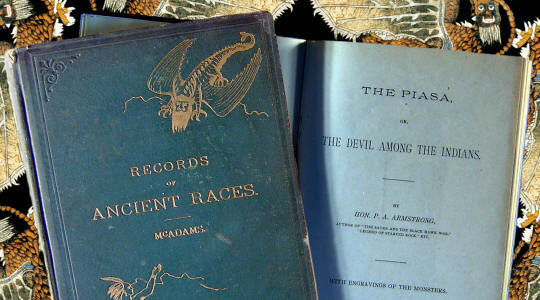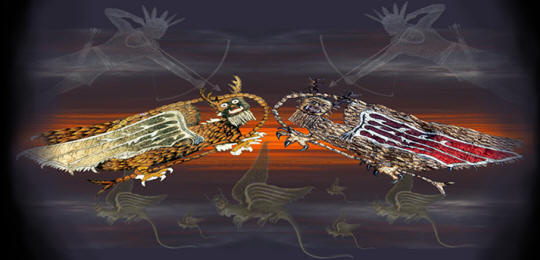|
(In
reference to southeastern Mississippian cultural mythology)
"Both the Above or Celestial World and the watery Below or Beneath
Worlds are equally essential sources of sacred power. For example,
abominable and anomalous below world creatures, known variously as
Uktenas, Piasa, Underwater Panthers, Horned Underwater Serpents, and the
great Serpent, were dangerous but useful sources of sacred objects, aid,
and knowledge."--------2007,
David H, Dye, "Ritual, Medicine, And The War Trophy Iconographic
Theme In The Mississippian Southeast," Ancient Objects And Sacred
Realms, Interpretations Of Mississippian Iconography, p. 156.
"The "pizha"
or "pissi" is better translated "panther" than as an alien "tiger," but
neither word catches the real meaning of the creature. It had the body
of a panther and four legs, but there was more, including a human head
(sometimes), an impossibly long tail, and horns."------2007,
George E. Lankford, "The Great Serpent In Eastern North America,"
Ancient Objects And Sacred Realms, Interpretations Of Mississippian
Iconography, p. 111.
"It
has been suggested that these four-legged animals with extremely long
tails, either straight or curled into a spiral, may instead be
representations of the previously mentioned mythological creature known
as the Piasa, uktena, "underwater spirit," or "water spirit."----2000,
Carol Diaz-Granados and James R. Duncan, "The Petroglyphs And
Pictographs Of Missouri," p. 154.
"Piasa is not just a theme in the sense we are
using the word here. It represents a deep substratum of meaning, capable
of endless combinations and variations, impossible of exact definition
or complete exemplification (illustrating by
example)"---------1975,
Philip Phillips, James A. Brown, "A Protean Manifestation: The Piasa,"
Pre-Columbian Shell Engravings, From
The Craig Mound At Spiro, Oklahoma, p. 140.
"A minimal
definition of the Piasa as manifested at Spiro (Oklahoma)
is offered on condition that it not be taken too seriously: a composite
animal that may include cat, snake, bird, deer, fish, raccoon, and human
elements, in that general order of numerical (but
not necessarily conceptual)
importance"---------1975,
Philip Phillips, James A. Brown, "A Protean Manifestation: The Piasa,"
Pre-Columbian Shell Engravings, From
The Craig Mound At Spiro, Oklahoma, p. 140.
"That an
individual artist can visualize the Piasa so differently gives an idea
of what we may expect where different artists (and different cultures)
are involved"---------1975,
Philip Phillips, James A. Brown, "A Protean Manifestation: The Piasa,"
Pre-Columbian Shell Engravings, From
The Craig Mound At Spiro, Oklahoma, p. 141.
"Pictograph
has come to mean an image painted on rock, rather than pecked or grooved."--------1998,
Sabra Moore, "Petroglyphs, Ancient Language/sacred Art," p.
62.

MARQUETTE'S PIASA
LEGEND, HISTORY & MYTHOLOGY
LATE STONE AGE PICTOGRAPH
MADISON COUNTY, ILLINOIS
Everything written about the Piasa "monster"
begins with the French explorer Marquette. He was the first European to
record, as he says, "two painted monsters which at first made us
afraid." Ever since that time, the Piasa images he recorded have been a
popular subject among authors, artists and archaeologists. If the images
had never appeared on the bluffs at
Alton, the subject would still exist but relegated to archaeological
studies of local/regional iconography and the general public would have
little interest. But Marquette's Piasa is no different than any other
legend. Eventually the facts blend with fiction and author/historians
spend a lot of time struggling to separate the two. That's what makes
the Piasa such an interesting phenomenon. |
|

IMAGE CREDIT ALTON MUSEUM OF HISTORY & ART---COMPUTER ALTERED BY PETE BOSTROM
PIASA FIRST DESCRIBED BY
MARQUETTE
This abstract image illustrates the
1673 discovery of the two Piasa pictographs that were seen by French
explorer Father Jacques Marquette on the bluffs at Alton, Illinois.
His description of the pictographs were recorded in his journal that
described his trip down the Mississippi River. He describes the
discovery as; "While skirting some rocks, which by their height and
length inspired awe, we saw upon one of them two painted monsters
which at first made us afraid, and upon which the boldest savages
dare not long rest their eyes. They are as large as a calf; they
have horns on their heads like those of a deer, a horrible look, red
eyes, a beard like a tiger's a face somewhat like a man's, a body
covered with scales, and so long a tail that it winds around the
body, passing above the head and going back between the legs, ending
in a fish's tail. Red, green and black are the three colors
composing the picture. Moreover, these 2 monsters so well painted
that we cannot believe that any savages in their author, for good
painters in France would find it difficult to paint so well, and
besides, they are so high up on the rock that it is difficult to
reach the place conveniently to paint them." It is interesting to
note that although Marquette did not describe wings in his account,
almost all the depictions of the Piasa in historical and
modern times show
the image with wings. |
|
|
The use of Piasa style iconography began sometime during the
late prehistoric period, either in the Mississippian or the earlier Woodland
periods, more than 800 years before Marquette.
Father Jacques Pere Marquette is the first European explorer to describe
them. His 1673 journey down the Mississippi River observed the paintings
on a high bluff near the future river town of Alton, Illinois. His
dramatic account of the Piasa images is-as-follows; "While skirting some
rocks, which by their height and length inspired awe, we saw upon one of
them two painted monsters which at first made us afraid, and upon which
the boldest savages dare not long rest their eyes. They are as large as
a calf; they have horns on their heads like those of a deer, a horrible
look, red eyes, a beard like a tiger's, a face somewhat like a man's, a
body covered with scales, and so long a tail that it winds around the
body, passing above the head and going back between the legs, ending in
a fish's tail. Red, green and black are the three colors composing the
picture. Moreover, these two monsters are so well painted that we cannot
believe that any savage is their author, for good painters in France
would find it difficult to paint so well, and besides, they are so high
up on the rock that it is difficult to reach the place conveniently to
paint them." He goes on to say, "Here is approximately the shape of
these monsters, as we have faithfully copied it." But he later reports
that the drawing was lost when the canoe overturned. |
|
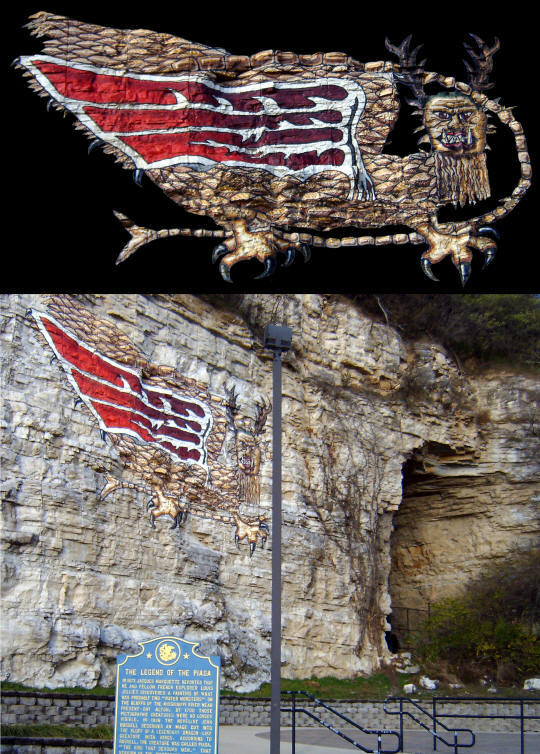
CLICK ON PICTURE FOR LARGER IMAGE
PAINTING OF THE PIASA
AS IT APPEARS TODAY AT PIASA PARK
GREAT RIVER ROAD AT ALTON, ILLINOIS
This picture shows the most
recent painting of the Piasa. It was created in 1998 by artist Dave
Stevens from Godfrey, Illinois and measures 48 feet long and 22 feet
high! It's located along the Great River Road
in a new facility called the Piasa Park. The park covers an area of 2.5
acres within the old limestone quarry. The park features restrooms, bike
trail, small picnic shelter and paved parking. Various renditions of the
original pictograph have been painted on the Mississippi River bluff at
Alton, since 1924. |
|
|
Some parts of Marquette's short description seem
mysterious. His comment that the "painted monsters" with "a horrible
look made them afraid" seems odd and suggests a superstitious response
rather than just a purely scientific observation. The paintings were
small from his perspective, as he says, "as large as a calf." If the
paintings were high on the bluff and the size of a calf, about four or
five feet, it would seem that they shouldn't be very intimidating.
Today's painting of the Piasa is nearly 50 long! Another comment that is
curious is, "good painters in France would find it difficult to paint so
well." It's an odd comment because no one else was ever nearly so taken
by the quality of the painting. In fact, a man named Douay, who visited
the locality on his journey from Texas, described Marquette's Piasa in
1687 and considered the original description as exaggerated saying;
"This frightful monster is a horse painted on a rock with matachia (an
old term for paint) and some other wild beasts made by the Indians" and
in 1687 Henri Joutel described them as, "two scurvy figures painted in
red." Also, in 1699 St. Cosme, a Missionary priest reported the images
as, "some figures that were almost effaced (erased)." There are no
reports of the Alton Piasa from the 1700's. But the most obvious
part of the description that's been difficult to understand, is the fact
that he didn't describe any wings. Even though he doesn't mention wings,
all the Piasa images drawn by later historical and modern artists have
large wings. In fact, Marquette's Piasa is referred to as the Piasa
bird. It would be interesting to know how far away from the rock
paintings he was during his observation and if he had a spy glass to
view them up close. Marquette is reported to be a good draftsman by
Agnes Repplier who wrote his biography. The only explanation for wings may be from a man named Spencer
Russell who claimed to have seen the wings when the rock was wet. But
it's interesting to note that Spencer was the son of John Russell and
both had written fictional stories about the Piasa. John Russell's 1836
article is still today's "Piasa Legend" story. |
|
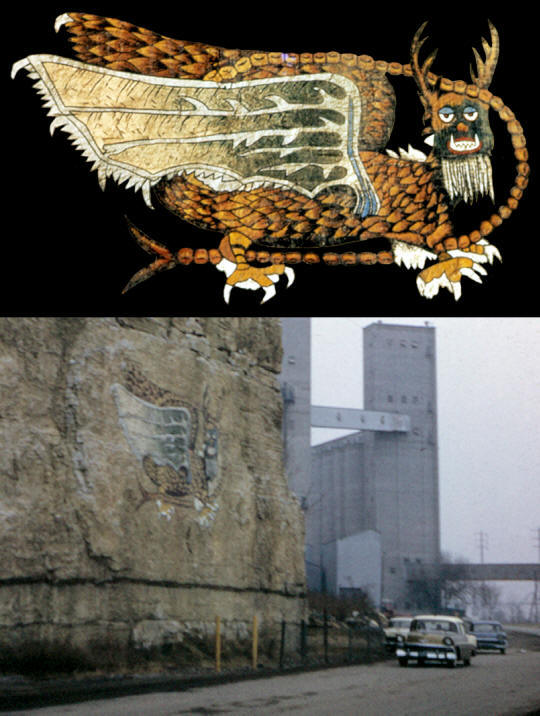
PHOTO BY BILL FECHT
CLICK ON PICTURE FOR LARGER IMAGE
PAINTING OF THE PIASA
SOMETIME IN 1950'S OR 1960'S
ALONG GREAT RIVER ROAD AT ALTON, ILLINOIS
This is one of the earlier
paintings of the Piasa. The picture was taken by Bill Fecht sometime
in the 1950's or 1960's. Because the paint doesn't last for very long,
the Piasa images have been repainted many times. The earliest painting is reported to have been
done in 1924 by Herbert Forcade who was eighteen years old at the time
and a Boy Scout. J. H. Mawdsley, a Shurtleff college student, repainted
the image in 1935 with funds from John McAdams and restored it in 1938
with red and green colors that replaced his earlier use of yellow. The next Piasa was
painted in 1952 by Jack Buese and Eldon Grove. In 1963 the Piasa was
painted by Ben DeMond on the rock at Norman's Landing. The next
painting, in 1983, was financed by the Alton/Godfrey Rotary Club and was painted on a very large piece of metal plate that
was bolted to the rock at Norman's Landing. The present day Paisa was created in 1998 by
artist Dave Stevens from Godfrey, Illinois.
It's interesting to note that Agnes Repplier, who wrote a
biography of Marquette, mentions that the historian Fredrick Parkman,
"was infinitely amused by the proposal of some enthusiasts in his day
(mid-1800's) to repaint the figures as described by Pere Marquette. The
difficulty of the task, rather than its utter and complete inexpedience,
induced them to abandon the design." When the historian passed away in
1867 she wrote, "the rock once defied by the Indians bore a huge and
harmless advertisement of "Plantation Bitters." Repplier also mentions
that Marquette's original Piasa was regarded by the pious missionary as
a symbol of deadly sin. |
|
|
Marquette described the original size of the two Piasa
paintings as the size of a calf. Compared to today's modern renderings
of the Piasa, Marquette's would be very small in comparison. In fact,
today's Piasa could hold the original one in its mouth. For a comparison
in size, the Piasa that was painted on metal plate and once bolted to the limestone wall measured 39 feet across. The present
day painting of the Piasa is even larger. It measures 48 feet long and
22 feet high! |
|

PAINTING OF THE PIASA ON METAL
PLATE
MADISON COUNTY, ILLINOIS
This picture shows the
current location of the 1983 Piasa painting that was done on metal plate
that measures 39 feet across. Funds were raised for the project by the
Alton/Godfrey Rotary Club and the very large and heave sign was bolted
to the bluffs next to the Great River Road. But this version of the
Piasa was removed in 1996 by the landowners because the increased traffic flow
became a nuisance. It was originally attached to the limestone quarry wall, along
the Mississippi River at Norman's Landing at Alton, Illinois, near the
original location. It was later removed from the
bluffs and stored under the Alton Clark Bridge where it was again moved
to a new Sports Complex at Southwestern high School. The Piasa image
represents the school's mascot. The corroded metal sign was refurbished by
the industrial art students. |
|
|
It's interesting to note that Agnes Repplier, who
wrote a biography of Marquette, mentions that the historian Fredrick
Parkman, "was infinitely amused by the proposal of some enthusiasts in
his day (mid-1800's) to repaint the figures as described by Pere
Marquette. The difficulty of the task, rather than its utter and
complete inexpedience, induced them to abandon the design." When the
historian passed away in 1867 she wrote, "the rock once defied by the
Indians bore a huge and harmless advertisement of "Plantation Bitters."
Repplier also mentions that Marquette's original Piasa was "regarded by
the pious missionary as a symbol of deadly sin." |
|
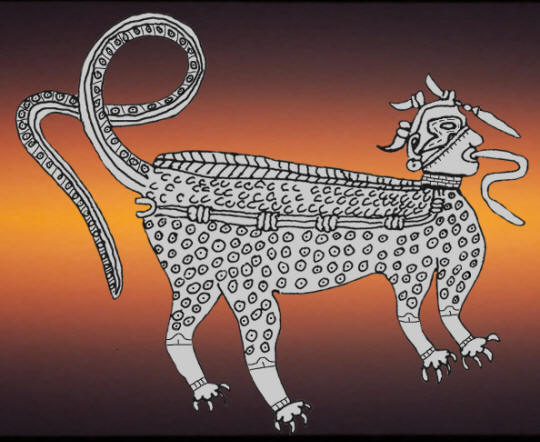
FROM DRAWING BY PETE BOSTROM OF SPIRO SHELL ENGRAVING
PIASA WITH HUMAN HEAD
ENGRAVED ON SHELL CUP
MISSISSIPPIAN PERIOD
SPIRO MOUND SITE
800 A.D. TO
1450 A.D.
LE FLORE CO., OKLAHOMA
This engraved image on a Spiro shell cup relates to Marquette's
Piasa. There are other Piasa-like images on Mississippian period
ceramic and shell cups and pots that are also similar to
Marquette's description. This image was engraved on a conch shell cup that was found
during the excavation of Craig Mound on the Spiro Mounds site in Le
Flore County, Oklahoma. Spiro Mounds was closely related to Cahokia
Mounds. It's interesting to note that Marquette did not describe the wings that are on every
modern Piasa that is seen today. This engraving is very detailed, and
even more-so on the original. The quality of this image might be
what Marquette was referring to when he commented that "good painters in France would find it difficult to
paint so well."
Archaeologists refer to the Piasa as a protean manifestation.
In-other-words referring to Proteus, the God who could change his shape.
The word Piasa originates from the Algonkian-speaking Illinois who are
assumed to have occupied the area in late prehistoric times. But
Piasa related mythology and iconography has been referred to by many
different names that relate to the Proteus idea. They are believed to generally
represent the same mythological being in the form of the "great serpent" (not
the feathered serpent). "Some" of the
terms used by various historians and native groups are the great
serpent, horned water serpent, underwater panther, boss of the
underworld, fabulous animal, the great panther, the great tiger, a sea
tiger, true tiger, a huge brown cat, and mishebeshu. |
|
|
The Alton Piasa has been repainted many times. The paint does
not last and as a result, several different images of the Piasa have
been repainted on the bluff over the years. The earliest painting is
reported to have been done in 1924 by Herbert Forcade who was eighteen years old at the time
and a Boy Scout. J. H. Mawdsley, a Shurtleff college student, repainted
the image in 1935 with funds from John McAdams and restored it in 1938
with red and green colors that replaced his earlier use of yellow. The next Piasa was
painted in 1952 by Jack Buese and Eldon Grove. In 1963 the Piasa was
painted by Ben DeMond on the rock at Norman's Landing. The next
painting, in 1983, was financed by the Alton/Godfrey Rotary Club and was painted on a very large piece of metal plate that
was bolted to the rock at Norman's Landing. The present day Paisa was created in 1998 by
artist Dave Stevens from Godfrey, Illinois. |
|
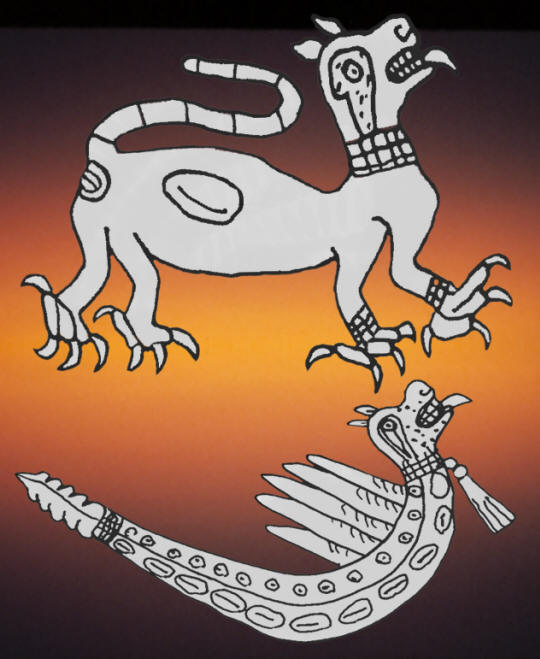
FROM DRAWINGS BY PETE BOSTROM OF SPIRO SHELL ENGRAVINGS
SHELL CUP ENGRAVINGS OF
PIASA-LIKE IMAGES
MISSISSIPPIAN PERIOD
SPIRO MOUND SITE
800 A.D. TO
1450 A.D.
LE FLORE CO., OKLAHOMA
Both of these mythological
creatures were engraved on conch shell cups that were found during the
excavation of Craig Mound on the Spiro Mounds site. They illustrate some
of the fearsome looking "creatures" that were used to represent
mythological beings that inhabit the under-world. These two examples
also illustrate that not all Piasa images have wings. Piasa figures are
described as belonging to a super-theme of different animal
combinations. A total of six different animal and human elements have
been reported on shell engravings from Spiro that occur in different
associated combinations. Theoretically, they can represent a Piasa image
in endless variations. The animals that have been observed on Spiro
artifacts that form Piasa-like "creatures," include cat, snake, bird,
deer, fish, raccoon, plus the human element. Archaeologists report that
there seems to be a minimum of three or four of these figures present
when representing a
Piasa themed figure. One of which must include a cat. |
|
|
Marquette did make a drawing of the Piasa but it was reported
to be lost when the canoe overturned. The first recorded "small"
artists painting or drawing of the Piasa was done in 1876 by Timothy Fellows
Ladd from Whitehall, Illinois. He is the first person, 203 years after
Marquette, to attempt an illustration of the Piasa image! |
|

CAT SERPENT BOWL
MISSISSIPPIAN CULTURE
Cat serpent images on
Mississippian bowls may represent one of the figures that make up a
Piasa "monster." Many of them were made to look as fearsome as
possible. People sometimes refer to them as a water panther. |
|
|
Marquette's Piasa paintings are categorized as pictographs,
as opposed to petroglyphs. Pictographs are defined as images that are
painted on rock. Petroglyphs are images and inscriptions that are cut
into the rock. The Alton Piasa pictographs are the first examples ever
recorded in the region around the states of Illinois and Missouri. The
state of Missouri is reported to have more pictographs and petroglyphs
than any other state in the Eastern Woodlands. |
|
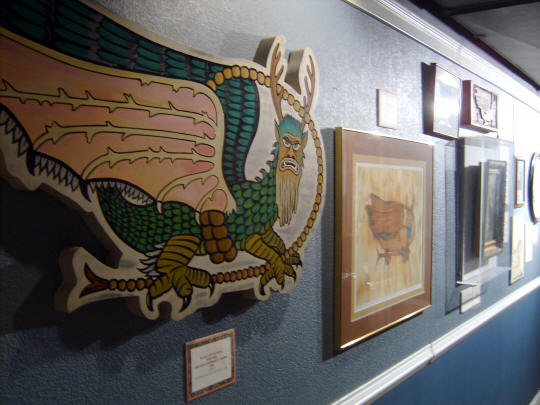
PIASA DISPLAY
ALTON MUSEUM OF HISTORY AND ART
ALTON, ILLINOIS
The Alton Museum
of History and Art has the best display of Piasa related paintings,
prints and related art. The various images of the Piasa are represented
in wood, cloth, metal and paper. The museum is also famous for its
collection of Walter Wadlow ("the Alton giant") related artifacts. |
|
|
The colors of the two Piasa images, as described by
Marquette, were red, black and green. The paint was made from natural
earth pigments. The color red was made from iron oxide. The color black
from charcoal and green from copper minerals. A liquid binder would have
been added to help the paint adhere to the rock. Some examples of
binders would be plant juices, eggs, animal fat or water. The paint
could be applied with fingers or simple plant fiber
brushes. |
|
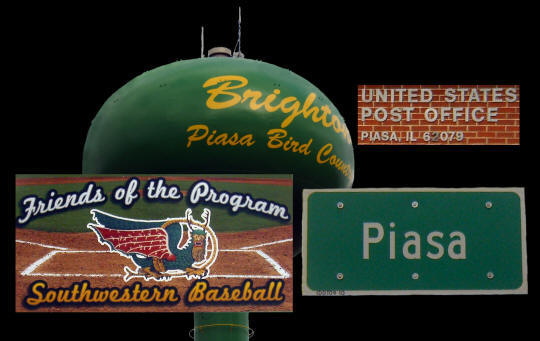
LOCAL PIASA SIGNS
PIASA & BRIGHTON, ILLINOIS
MADISON COUNTY, ILLINOIS
These pictures were taken in towns around Alton, Illinois, in Piasa
and Brighton. They show how popular the Piasa image is in the area
around Alton.
As the water tower in Brighton says, "Piasa Bird Country." The name
or image can be seen on schools, baseball diamonds and the
Post Office. |
|
|
Authors have been writing stories, descriptions and
accounts about the Alton Piasa for hundreds of years. Most of them are
just stories with little evidence. The one Piasa story that has stood
the test of time and is today's "Legend Of The Piasa" was written
by John Russell in 1836. The original article was titled "The Piasa, An
Indian Tradition Of Illinois," and published in the Illinois Monthly
Magazine out of Vandalia. The story portrays the Piasa as a flying
monster that ate members of a local Indian tribe. It ends with the the
chief using himself as bait. As the monster comes to eat him twenty
archers kill the Piasa leaving the hero chief unharmed. John Russell
lived north of Eldred in Bluffdale, Illinois and was a teacher at the
Alton Seminary. He never intended that his story should be believed as a
factual historical account. |
|
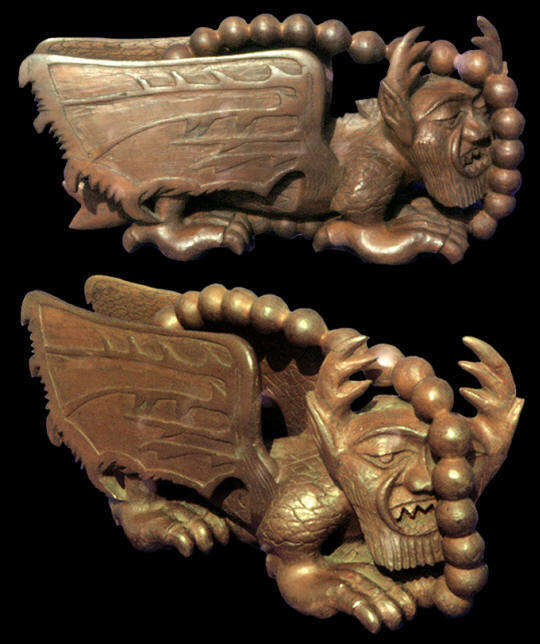
WOOD CARVING OF THE PIASA
PRIVATE COLLECTION
This may be the best, or at
least one of the very best, wood carvings that has ever been done of the
Piasa. It was purchased from the artist many years ago by Bill Fecht. The carving is done in such high relief that it
illustrates a unique three dimensional representation of the Piasa. |
|
|
Archaeologists now have a much better understanding of
Marquette's Piasa. Many similar images are known from engravings on
shell cups and ceramic pots. The best source comes from the engraved
shells that were dug from
Craig Mound on the
Spiro Mounds site. Other examples have also been found at Moundville in
Alabama. Style is a cultural phenomenon. So it's not
surprising that other Piasa images are being found on culturally related
late prehistoric artifacts. |
|
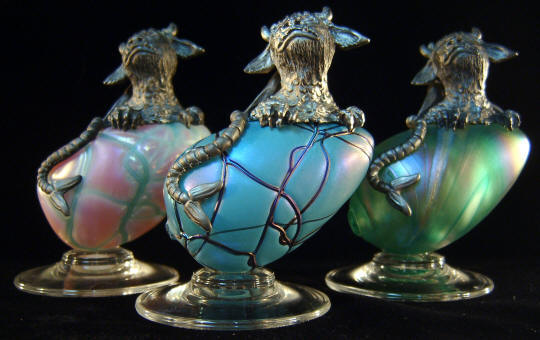
GLASS & METAL PIASA ART PIECES
PRIVATE COLLECTION
These glass and metal art pieces were made by a local art glass
studio in 1994 in Alton, Illinois. They were called Piasa Eggs and
represent a Piasa "bird" that is hatching from an egg. The name of
the company that made them was Intaglio. The company went out of
business during the time they were making these limited edition eggs
so they probably didn't make very many of them. But they are
good representative examples of Piasa art that's been on going in
the Alton area for many years. |
|
|
Piasa figures are described as belonging to a
super-theme of different animal combinations. A total of six different
animal and human elements have been reported on shell engravings from
Spiro that occur in different associated combinations. Theoretically,
they can represent a Piasa image in endless variations. The animals that
have been observed on Spiro artifacts that form Piasa-like "creatures,"
include cat, snake, bird, deer, fish, raccoon, plus the human element.
Archaeologists report that there seems to be a minimum of three or four
of these figures present when representing a
Piasa themed figure. One of which must include a cat. |
|

BRONZE CAST OF PIASA SCULPTURE
ALTON MUSEUM OF HISTORY AND ART
COLLECTION
ALTON, ILLINOIS
This is another example of
Piasa imagery art. This piece is on display in the Alton Museum of
History and Art. It appears to represent a Piasa "bird" that is
protecting an egg. The metal seems to be bronze and it measures around
12 or 18 inches tall. |
|
|
Archaeologists refer to the Piasa as a protean manifestation.
In-other-words referring to Proteus, the God who could change his shape.
The word Piasa originates from the Algonkian-speaking Illinois who are
assumed to have occupied the area in late prehistoric times. But Piasa
related mythology and iconography has been referred to by many different names
which relates to the Proteus idea. They are believed to generally
represent the same mythological being in the form of the great serpent (not
the feathered serpent). "Some" of the
terms used by various historians and native groups are the great
serpent, horned water serpent, underwater panther, boss of the
underworld, fabulous animal, the great panther, the great tiger, a sea
tiger, true tiger, a huge brown cat, and mishebeshu. |
|
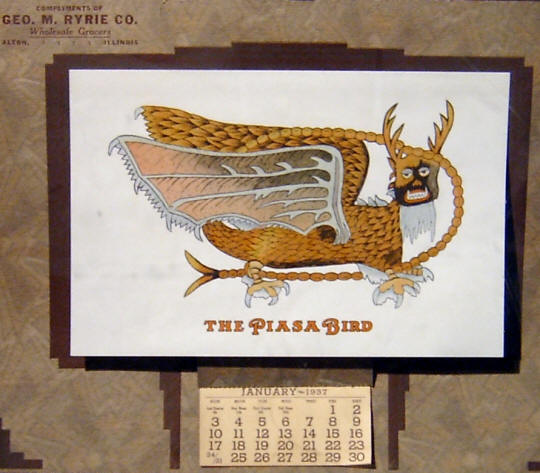
AN OLD PIASA CALENDAR
ALTON MUSEUM OF HISTORY AND ART
COLLECTION
ALTON, ILLINOIS
A 1937 Piasa Bird calendar on display in the Alton Museum of
History and Art. Representing one of the many Piasa related artifacts
that are on display. |
|
|
All the animal and
animal/human images that fall under the great-serpent super theme are
considered under-world beings in the form of creatures, spirits,
denizens, and supernaturals. Not all of them have wings but it's
believed that the wings serve to allow these underworld beings to rise a
little above the surface into the celestial above-world. But not very
high and the occasion may relate to an astronomical event, such as, when
a constellation rises above the horizon. The above and below-ground
spirit-beings were thought to have great powers that tribal priests
could sometimes acquire in the form of aid. |
|
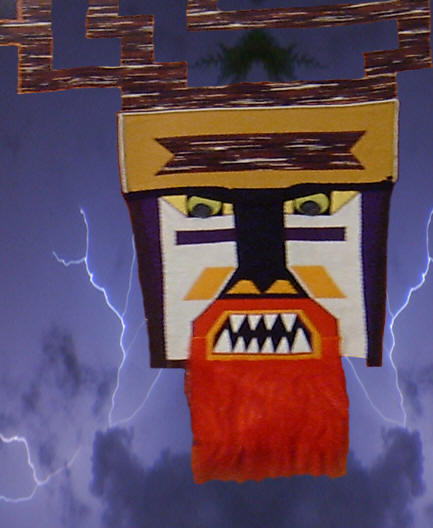
COMPUTER GENERATED ABSTRACT ART BY PETE BOSTROM
ABSTRACT IMAGE OF PIASA ART
ALTON MUSEUM OF HISTORY AND ART
COLLECTION
ALTON, ILLINOIS
This abstract image shows
the head of a large Piasa art piece that was done in cloth and is on
display in the Alton Museum Of History And Art. |
|
|
In today's modern world, Marquette's Piasa seems to become
more popular with each passing year. Culminating recently with the very picturesque
Piasa Park. Even the paintings on the limestone wall have grown in size
and artistic quality as the years go by. So it's a good bet that the Piasa
phenomenon, in legend, mystery and science is
here to stay. |
|
"REFERENCES"
1882, W. R. Brink & Company, "History
Of Madison County, Illinois," pp. 374-375.
1887, McAdams, W. M., "Records Of Ancient Races In The Mississippi
Valley."
1887, Armstrong, Hon. P. A., "The Piasa Or The Devil Among The
Indians."
1912, Hodge, Fredrick Webb, "Piasa,"
Handbook Of North American Indians North Of Mexico, Smithsonian
pub., p. 241.
1929, Repplier, Agnes, "Pere Marquette," pp. 95-96.
1960, Perino, Gregory, "The Piasa Design In Arkansas." Central
States Archaeological journal, Vol. 32 No. 4, pp. 146-149.
1975, Phillips, Philip, Brown, James A., "A Protean Manifestation:
The Piasa," Pre-Columbian Shell Engravings, From The Craig Mound At
Spiro, Oklahoma, pp. 140-143.
1985, Fecht, Bill, "New Thoughts On The Piasa Bird Legend,"
Central States Archaeological journal, Vol. 7 No. 4, pp. 175-179.
1990, Sparks, Everett L., "In Search Of The Piasa."
1994, Intaglio Company brochure, "The First Limited Edition Piasa
Egg Collection."
1998, Moore, Sabra, "Petroglyphs, Ancient Language/Sacred Art"
p. 62.
2000, Diaz-Granados, Carol & Duncan, James R., "The Petroglyphs And
Pictographs Of Missouri," p. 154 & notes.
2007, Dye, David H, "Ritual, Medicine, And The War Trophy
Iconographic Theme In The Mississippian Southeast," Ancient Objects And Sacred
Realms, Interpretations Of Mississippian Iconography, p. 156.
2007, Lankford, George E., "The Great Serpent In Eastern North
America,"
Ancient Objects And Sacred Realms, Interpretations Of Mississippian
Iconography, p. 111.
2011, Taylor, Troy, "Monsters Of Illinois."
Alton Museum Of History And Art
Personal Communication, Kent Patterson
|
|
RECENT
LISTINGS HOME
ORDERING |
